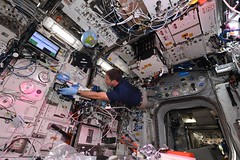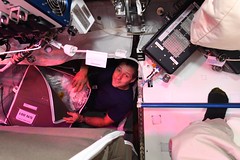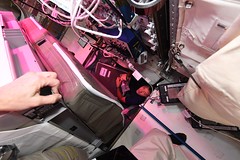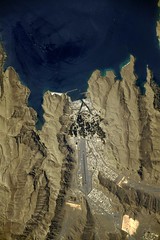Thomas Pesquet posted a photo:

Le laboratoire des fluides FSL se trouve au plafond de Columbus, d’où le côté quand on y travaille. Cette fois-ci, on travaillait sur les mousses en impesanteur. Sur Terre, les effets de la gravité entraînent inévitablement un drainage de la mousse : le liquide est attiré vers le bas, les bulles montent, les plus grosses d’entre elles prennent la place des plus petites, puis éclatent à leur tour, et ainsi la mousse disparaît rapidement pour reprendre un état liquide. Affranchis de ce facteur dans l’espace, les fluides produisent beaucoup plus de mousse et cette dernière est plus stable que sur Terre. De quoi permettre aux scientifiques d’observer avec précision l’évolution d’une bulle qui grossit avant d’éclater, et le comportement des mousses de manière générale ! Les applications dans la vie de tous les jours vont de l’agro-alimentaire aux produits d’hygiène, en passant par les matériaux de protection (bruits, chocs). Et comment crée-t-on de la mousse sur la Station ? En secouant les cartouches de liquides, tout simplement…
Working on Fluid Science Laboratory on the ceiling in Columbus, like a bat (and Aki photobombing my timelapse). The FSL (of course we call it by its acronym!) is a facility that offers researchers a place to experiment with... fluids. :joy: On this particular day we were running the Foam Coarsening experiment, making foams by shaking them and researchers on Earth can study them. Why do this in space? Well on Earth, their own weight breaks foams down quickly, so it is easier to understand all the complex processes behind foams if you remove this external factor and run the experiments in weightlessness. This is typical of science in general, to investigate how light behaves, you would generally run an experiment in a dark room so you can concentrate on the light that interests you. Why foams though? Well they are more prevalent than you might think, especially in food: cappuccino, chocolate mousse and much, much, more... www.esa.int/ESA_Multimedia/Images/2020/06/Foam_of_coarse
Credits: ESA/NASA–T. Pesquet
607D5587




